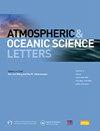Characteristics of tropical cyclone outflow over the western North Pacific
IF 3.2
4区 地球科学
Q3 METEOROLOGY & ATMOSPHERIC SCIENCES
引用次数: 0
Abstract
This study employs the self-organizing map method to investigate the upper-tropospheric outflow patterns of tropical cyclones (TCs) over the western North Pacific from 1979 to 2019, using the 200 hPa horizontal wind fields from the ERA5 reanalysis datasets. According to the number and orientation of TC outflow channels, as well as the wind speed, the outflow patterns are classified into five categories: southwestward single-channel pattern S1 (26.1%); northwestward single-channel pattern S2 (23.6%); northeastward single-channel pattern S3 (23.6%); double-channel outflow pattern D (20.8%); and high latitude outflow pattern H (6.0%). Composite analysis shows that the orientations of the TC outflow channels are aligned with the direction of the environmental vertical wind shear and closely related to the distribution of the environmental inertial instability, upper-level divergence, and inner-core convective activities. TC intensity and intensity changes for different outflow patterns are also significantly different. Patterns S1 and S2 usually appear in the development phase and are thus prone to TC intensification, while patterns S3 and H usually occur in the weakening phase and are thus prone to TC weakening. The double-channel pattern (D) has the largest mean intensity and accounts for more than 60% of super-typhoon samples.
摘要
本文基于欧洲中期天气预报中心第五代大气再分析数据集 (ERA5) 的200 hPa水平风场数据, 借助自组织映射网络方法对1979–2019年间西北太平洋热带气旋的流出层特征进行了客观分型研究. 根据流出通道的数量, 方向以及风速大小等特征, 西北太平洋热带气旋流出层主要可分为五种流出类型: 西南向单流出通道型 (26.1%); 西北向单出流通道型 (23.6%); 东北向单流出通道型 (23.6%), 双流出通道型 (20.8%) 以及高纬度流出通道型 (6.0%). 不同流出通道类型对应的热带气旋高层热力, 动力结构具有显著差异, 流出通道的方向与高层惯性稳定度, 散度场, 以及热带气旋内核区对流活动的分布等密切相关. 同时, 流出通道类型与热带气旋的强度及强度变化也具有密切联系. 西南和西北向单通道流出型主要发生在增强阶段, 具有东北向单流出通道和高纬流出通道的热带气旋则更倾向于衰减. 双流出通道型的热带气旋样本具有最大的平均强度, 且热带气旋强度越强, 双流出通道出现的频率越大, 占强热带气旋样本的60%以上.

北太平洋西部热带气旋外流的特征
本研究利用ERA5再分析数据集的200 hPa水平风场,采用自组织图方法研究了1979 - 2019年北太平洋西部热带气旋对流层上层外流模式。根据TC流出通道的数量、流向和风速,将TC流出类型划分为5类:西南单通道S1型(26.1%);西北向单通道S2 (23.6%);东北单通道模式S3 (23.6%);双通道流出型D (20.8%);高纬度外流型H(6.0%)。综合分析表明,TC流出通道的走向与环境垂直风切变方向一致,与环境惯性不稳定性、高层辐散和内核内部对流活动的分布密切相关。不同流出模式的TC强度和强度变化也有显著差异。S1和S2型多出现在发展阶段,易发生TC增强,S3和H型多出现在减弱阶段,易发生TC减弱。双通道模式(D)的平均强度最大,占超级台风样本的60%以上。摘要本文基于欧洲中期天气预报中心第五代大气再分析数据集(ERA5)的200 hPa水平风场数据,借助自组织映射网络方法对1979 - 2019年间西北太平洋热带气旋的流出层特征进行了客观分型研究。根据流出通道的数量,方向以及风速大小等特征,西北太平洋热带气旋流出层主要可分为五种流出类型:西南向单流出通道型(26.1%);(23.6%);东北向单流出通道型(23.6%),双流出通道型(20.8%)以及高纬度流出通道型(6.0%)。不同流出通道类型对应的热带气旋高层热力, 动力结构具有显著差异, 流出通道的方向与高层惯性稳定度, 散度场, 以及热带气旋内核区对流活动的分布等密切相关. 同时, 流出通道类型与热带气旋的强度及强度变化也具有密切联系. 西南和西北向单通道流出型主要发生在增强阶段, 具有东北向单流出通道和高纬流出通道的热带气旋则更倾向于衰减. 双流出通道型的热带气旋样本具有最大的平均强度, 且热带气旋强度越强, 双流出通道出现的频率越大, 占强热带气旋样本的60%以上.
本文章由计算机程序翻译,如有差异,请以英文原文为准。
求助全文
约1分钟内获得全文
求助全文
来源期刊

Atmospheric and Oceanic Science Letters
METEOROLOGY & ATMOSPHERIC SCIENCES-
CiteScore
4.20
自引率
8.70%
发文量
925
审稿时长
12 weeks
 求助内容:
求助内容: 应助结果提醒方式:
应助结果提醒方式:


